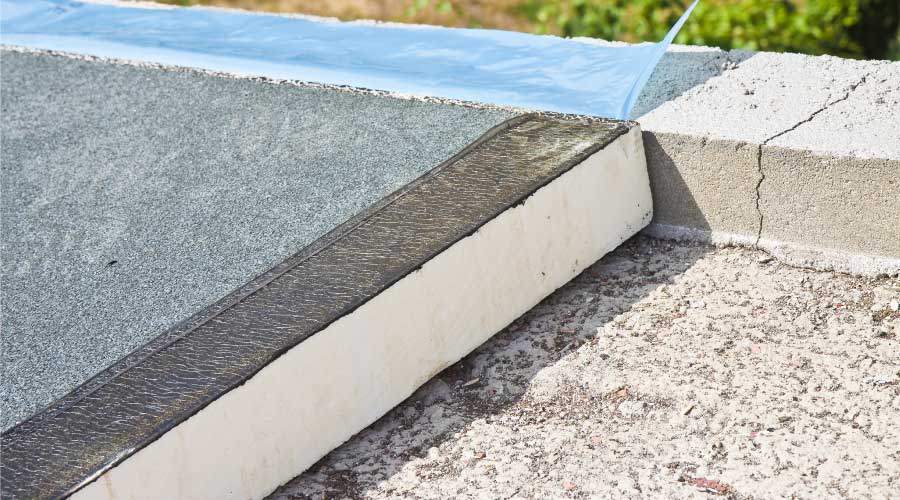Energy Opportunity
INSULATION is often a cost-effective way to reduce energy use in new and existing buildings
Buildings represent 40 percent of global energy consumption. What’s more, nearly 39 percent of carbon emissions come from buildings. Those numbers make it clear that use of existing energy-efficiency technologies, such as insulation, is fundamental to successful sustainable development. In fact, insulation is often the lowest cost investment toward delivering energy efficiency to new buildings, and in some cases, even existing ones.
“Insulation is pretty cheap in comparison to other energy efficiency improvements you can make,” says R. Chris Mathis, president of Mathis Consulting.
As a component in a building system — roofing, walls, piping, ductwork — insulation boosts a facility’s thermal performance inexpensively and efficiently. In fact, without adequate insulation, many of the other energy-efficient components found in a building won’t perform as well as intended.
“Insulation by itself does not do all the things that need to happen in designing optimal thermal performance, but it plays a key role in the process when installed as part of a system,” says Paul Bertram, director of environment and sustainability at the North American Insulation Manufacturers Association (NAIMA). “It’s where you start to model for optimal efficiency, but it has to be done in a system.”
Too often, buildings are still built to code, with only a minimum of insulation. But codes are often outdated and do not reflect increased insulation requirements. “Building to meet code is not necessarily a prescription for a more sustainable building,” says Scott Miller, manager, product affairs at Knauf Insulation.
In fact, building to code is just a minimum. “Building to code is not the best building we can build,” he says. “It’s the worst one. And we need to keep in mind that sustainability starts, not with building to code, but building beyond code.”
Part of the problem is that many local codes are out of date, particularly in terms of energy efficiency. “It’s time we start looking at what kind of building performance can be achieved today to stop wasting energy and save building owners and occupants money,” says Michael B. Lynman, director of strategic marketing and communications at Knauf Insulation.
Code officials are beginning to understand this and have started to make significant changes, as the need to develop more energy-efficient buildings becomes increasingly obvious.
Consider the shifts in the standard that is the basis of many commercial building energy codes throughout the United States: the American Society of Heating, Refrigerating and Air-Conditioning Engineers (ASHRAE) Standard 90.1, “Energy Standard for Buildings Except Low-Rise Residential Buildings.”
The most recent version of the ASHRAE standard that is now widely used in model codes was released in 2004. A 2007 version that features more energy-efficient measures has yet to reach widespread implementation. ASHRAE, however, already is preparing for the next release of Standard 90.1, which will occur in 2010. This release will feature major changes from the 2004 version.
“These codes will create buildings that have 30 percent better energy performance simply by using off-the-shelf technology,” Miller says. “It won’t take anything new or different when it comes to insulation. You’ll just need to use more insulation products.”
Other organizations are striving for similar improvements to standards and guidelines, says Herb Slone, technical manager at Owens Corning. “The American Institute of Architects is setting a major goal of the net carbon footprint of buildings being zero by 2030,” he says.
Other Incentives
Beyond codes and standards, green building programs such as LEED also have increased interest in efficiency.
“We spend a lot of time talking with architects about envelope design from a lot of different angles,” Slone says. “One is LEED, where you score points for each sustainable concept designed into a building.” A facility can earn up to 10 points in LEED-NC for exceeding ASHRAE 90.1-2004 code by 42 percent, he says. Exceeding the standard by 10.5 percent will garner one point. Insulation can play an important role in those reductions.
The federal government also has become involved in promoting more energy-minded construction. The Energy Policy Act of 2005 (EPAct) offers a tax deduction of up to $1.80 per square foot to owners or tenants (or designers, in the case of government-owned buildings) of new or existing commercial buildings that are constructed or upgraded to save at least 50 percent of the heating, cooling, water heating and interior lighting energy cost compared to a building that meets ASHRAE Standard 90.1-2001.
Deductions of up to $0.60 per square foot can be taken for reductions from any one of three building systems — the building envelope, lighting, or heating and cooling system — that meets goals consistent with achieving the 50 percent savings for the entire building.
The commercial building tax deduction provision of EPAct initially covered property “placed in service after Dec. 31, 2005 and prior to Jan. 1, 2008.” That deadline was extended to Jan. 1, 2009. Congress is now considering measures that would extend the deadline and increase the size of the deduction.
“The more thermally insulated I can make a building, the easier it is to control and the better ability occupants have to maintain conditions in the space,” Mathis says. “Whether your thermostat setpoint is 68 degrees F or 75 degrees F, the better insulated you are, the better thermal management you will have in a building. Get it right at the start if you want to minimize your operating costs. Getting it right the first time around minimizes risks and maximizes a building’s future.”
Much of the focus on boosting energy efficiency through better insulation falls on new construction, but that’s not to say there aren’t ways to better insulate existing commercial buildings.
Insulating Existing Buildings
A place to start? The roof. “You will be amazed at how many people will replace the roof and not add insulation,” Mathis says. “When will you ever have a better opportunity to insulate? Most of these buildings have really sub-par levels of insulation.”
Beyond roofing, other insulation solutions for existing buildings include better insulating ductwork and piping and adding insulation to the exterior walls during major remodeling, where possible.
Beyond the increase in energy efficiency within a building, insulation also plays an important role in a facility’s indoor environmental quality (IEQ).
Occupant comfort, both thermal and acoustic, is an essential component of IEQ. Insulation products help maintain a consistent air temperature throughout the building, absorb noise and conserve energy. An air-sealed assembly with insulation also helps to keep out air that can bring in unwanted moisture, which can contribute to mold growth.
NAIMA at a Glance
Members of NAIMA, a trade association of North American manufacturers of fiber glass, rock wool, and slag wool insulation products, provide the vast majority of these kinds of insulations produced and used in North America.
Since its 1933 inception, the association has evolved with the construction industry, expanding its role to concentrate efforts on promoting energy efficiency and environmental preservation through the use of fiberglass, rock wool and slag wool insulation products. It also continues encourage safe production and use of these products.
The association and its member companies also work with many organizations to ensure that fiberglass, rock wool and slag wool insulation are installed correctly to maximize the performance of the building or mechanical system as well as to meet building codes, energy codes and OSHA regulations.
|
Related Topics:











